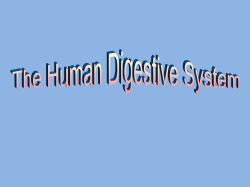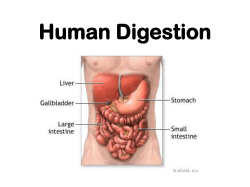
print version
The Human Digestive System: From Food to Energy and Waste Written By: Roxanne Light Date: March 25, 2015 Image courtesy of: http://blogs.egusd.net/eettalfonso/files/2014/04/Digestive-SystemDiaphragm-1pprblo.png 1 Audience and Scope This document offers a general, scientific overview of how the human digestive system works. It is necessary for people to eat so that they obtain energy. Energy keeps the body functioning, even during periods of rest and relaxation, and it allows people to actively participate in the world. More specifically, it keeps peoples’ hearts beating, lungs breathing, muscles moving, and brains working. As a person’s body processes food, not all of the food’s materials can be converted to energy or used otherwise; therefore, digestion also produces waste. As all humans have experienced, these wastes must eventually be excreted from the body. Chronologically following the process’ events, this document begins analyzing digestion at the moment food enters a person’s mouth. It explores the organs, enzymes, and hormones that are involved in breaking down this food into both energy and waste. Moreover, it distinguishes between the processing of carbohydrates, proteins, and fats, the energy-yielding nutrients found within food. This document is intended for an audience of freshman or sophomore undergraduate college students. Upon entering college, the audience most likely has little to no understanding of digestion. However, this process is usually addressed in introductory biology courses, human anatomy and physiology courses, and nutrition courses. This document is an informative resource that offers these students a comprehensive overview of the human digestive system and process. By reviewing this document, the audience may better review material they are learning in their undergraduate biology courses. 2 What is the Human Digestive System? The human digestive system is the system of organs and glands within the human body that is associated with the digestive tract and aids in the process of digestion (see Figure 1). Digestion is the process of breaking down food, via mechanical actions and chemical reactions, into the energy-yielding nutrients of carbohydrates, fats, and proteins and waste. The human digestive system involves organs of two main groups: alimentary canal organs and accessory digestive organs. Alimentary canal organs include the mouth, pharynx, esophagus, stomach, small intestine, and large intestine. These organs make up what is known as the digestive or gastrointestinal tract. Accessory digestive organs include the teeth, tongue, salivary glands, liver, gallbladder, and pancreas. These organs aid in the body's digestion of food as it passes through the digestive tract (Marieb and Hoehn 849-52). Figure 1: Image courtesy of: http://blogs.egusd.net/eettalfonso/files/2014/ 04/Digestive-System-Diaphragm-1pprblo.png 3 How does the Human Digestive System Work? As people eat, the food they place into their mouths travels down their pharynx, upon swallowing, and then, continues down their esophagus into their stomach and small intestine. Throughout this journey, enzymes completely digest food's carbohydrates, fats, and proteins. In the small intestine, the enzymes finish digesting the food's nutrients, which are then absorbed into the small intestine's cells. These absorbed nutrients travel via blood or lymph fluid to other cells throughout the body that either metabolize them for energy or use them as structural components. Remnants of food that are neither digested nor absorbed continue through the large intestine to the rectum. Eventually, they are eliminated as waste through the anus during defecation. The Mouth The mouth is the external opening through which people provide their body food and the entrance to the oral cavity. Therefore, the mouth is the beginning of the human digestive system. Once food enters the mouth, it succumbs to both mechanical actions and chemical reactions. The teeth, including the incisors, canines, pre-molars, and molars, work together to break down, cut, and grind the food into smaller fragments (Marieb and Hoehn 85960). Additionally, the tongue helps to position food Figure 2: Image courtesy of: between the teeth (Marieb and Hoehn 857; Whitney http://www.naturecures.co.uk/glands.htm and Rolfes 71-2). At the same time, saliva produced by the salivary glands (see Figure 2) enters the mouth (Freeman 847; Marieb and Hoehn 858; “National Digestive Diseases”; Whitney and Rolfes 72). Substances in saliva, including water, mucins, and digestive enzymes moisten and begin to digest the food (Freeman 847; Marieb and Hoehn 859). Salivary amylase, one digestive enzyme found in saliva, begins breaking down the food’s starches, a type of carbohydrate, into smaller fragments. Lingual lipase, another digestive enzyme found in saliva, begins breaking down the food’s fats into smaller fragments (Freeman 847; Khanacademymedicine; Marieb and Hoehn 859, 892-3; Whitney and Rolfes 72). Water and mucins mix to form a substance (mucus) that coats the food, making it easier to swallow (Freeman 847; Marieb and Hoehn 859). 4 Swallowing forces the moistened mass of broken-down food to begin its journey down the digestive tract. The mass of broken-down food, which is now referred to as a bolus, continues toward the pharynx (Marieb and Hoehn 857, 861-2; Whitney and Rolfes 72). The Pharynx The pharynx is a short tube that connects the oral cavity of the mouth with the esophagus and trachea. The trachea is the passageway that enables oxygen to travel to the lungs and carbon dioxide to travel from lungs and out of the body. It is covered by a flap of tissue made of cartilage known as the epiglottis (see Figure 3). When a person swallows, the epiglottis closes over the trachea, directing the bolus into the esophagus, not the airway (Whitney and Rolfes 71-2). After swallowing, the bolus continues to move through the digestive tract via the phenomenon of peristalsis. Peristalsis involves continuous muscular contractions of digestive tract that push the bolus toward the rectum and anus (Marieb and Hoehn 863-4; “National Digestive Diseases; Whitney and Rolfes 73). The Esophagus Figure 3: Image courtesy of: After passing through the pharynx, the bolus continues http://nicholasqdagostinos.blogspot.com/2011/ 09/pharynx-palate-and-epiglottis.html down through the esophagus (see Figure 3), a tube that connects the mouth to the stomach (Freeman 847; Khanacademymedicine; Marieb and Hoehn 862-4; “National Digestive Diseases”; Whitney and Rolfes 72). To enter the esophagus, the bolus passes through the upper esophageal sphincter, which opens upon swallowing (Whitney and Rolfes 72). Peristalsis forces the bolus down the esophagus, through the lower esophageal sphincter, and into the stomach (Marieb and Hoehn 862-4; “National Digestive Diseases”; Whitney and Rolfes 72). The Stomach The stomach is the most muscular organ of the digestive tract (Marieb and Hoehn 866). Upon entering the stomach, the bolus is held in the stomach's upper portion until it is gradually transferred into the lower portion (Whitney and Rolfes 72). When the bolus enters the stomach, it signals the G cells of the stomach to secrete gastrin (Marieb and Hoehn 870), a hormone that causes the parietal cells of the stomach to secrete hydrochloric acid (HCL-). The parietal cells continue to secrete HCL- until the stomach reaches a pH of approximately 1.5 (Freeman 849, 852; Marieb and Hoehn 866; Whitney and Rolfes 74-75, 83). 5 Simultaneously, chief cells of the stomach produce some gastric lipases, which continue to break down fats (Marieb and Hoehn 866), and pepsinogen, an inactive form of the enzyme pepsin. HCL- activates pepsinogen, converting it to pepsin (see Figure 4). Pepsin begins the breakdown of proteins (Freeman 849; Marieb and Hoehn 866, 894). Additionally, the acidic pH, which was caused by HCL-, inactivates salivary amylase. Because of the inactivation of salivary amylase, the digestion of carbohydrates ceases in the stomach (Whitney and Rolfes 75). Figure 4: Image courtesy of: http://bio1152.nicerweb.com/Locked/media/ch41/stomach.html 6 While all these actions occur, the muscular stomach contracts, mixing the bolus and gastric juices. This mixing produces chyme (Khanacademymedicine; Marieb and Hoehn 864, 866; “National Digestive Diseases; Whitney and Rolfes 72). The stomach's contractions push the chyme downward toward the pyloric sphincter, which guards the entrance to the small intestine. Periodically, the pyloric sphincter opens and closes, allowing small portions of chyme to enter the small intestine (Khanacademymedicine; Whitney and Rolfes 72). Note: Sphincters close immediately after the bolus or chyme passes through them to prevent the substances from flowing backwards up the digestive tract (Whitney and Rolfes 72-3). Heartburn results from the backflow of acidic chyme through the lower esophageal sphincter. This condition may result from eating or drinking in excess (Marieb and Hoehn 862-3; Whitney and Rolfes 92) or having a leaky or defective lower esophageal sphincter (Khanacademymedicine; Whitney and Rolfes 92). The Small Intestine The small intestine is the 10 to 20 foot segment of intestine that functions as the main site of digestion and absorption (Marieb and Hoehn 875, 884; Whitney and Rolfes 72). It is divided into three parts: the duodenum, the jejunum, and the ileum (Khanacademymedicine; Marieb and Hoehn 875; Whitney and Rolfes 72). Chyme moves through the small intestine by the phenomenon of segmentation, which involves muscular contractions similar to peristalsis except slower and steadier. The slower and steadier contractions allows more time for the substance to be fully digested and absorbed (Marieb and Hoehn 886). With help from the secretions of the pancreas, liver, and gallbladder, all three energy-yielding nutrients, proteins, carbohydrates, and fats, continue to be chemically digested within the small intestine (Marieb and Hoehn 884-5; “National Digestive Diseases”; Whitney and Rolfes 75). Figure 5: Image courtesy of: https://c1.staticflickr.com/1/57/219377097_594 a16a8b6.jpg The Completion of Digestion As chyme enters the duodenum, it causes duodenum cells to release the hormone secretin into the bloodstream. This hormone travels to the pancreas and signals for it to send its bicarbonaterich (HCO3-) juices to the duodenum via the pancreatic duct. The pancreas’ bicarbonate juices neutralize the acidic chime, thereby enabling intestinal and pancreatic enzymes to function (Freeman 852; Marieb and Hoehn 882-4; Whitney and Rolfes 84). 7 Moreover, if fat is present in the chyme, it causes the duodenum cells to release the hormone cholestokinin (CCK) into the bloodstream. This hormone also travels to the pancreas and gallbladder. CCK orders the pancreas to secrete its digestive juices into the duodenum. This digestive juice includes inactivated enzymes that become activated upon entering the duodenum. Additionally, CCK instructs the gallbladder to contract and send bile into the duodenum via the common bile duct (see Figure 5) (Freeman 852; Marieb and Hoehn 882-4; Whitney and Rolfes 84). Bile, which is made in the liver and stored in the gallbladder, is used to emulsify the fats (Freeman 853; Khanacademymedicine; Marieb and Hoehn 881; “National Digestive Disesases”; Whitney and Rolfes 75, 138-9). Emulsification breaks down the large fat globules into smaller globules, increasing their surface area (Freeman 853-4; Marieb and Hoehn 881). The higher surface area of these globules enables pancreatic lipases and intestinal lipases to attach to and continue digesting the fats (Whitney and Rolfes 76, 138-9). Note: Upon removal of the gallbladder, the liver will send bile directly to the duodenum of the small intestine (Whitney and Rolfes 84). As the lipases digest the fats, pancreatic amylases and intestinal amylases continue digesting the carbohydrates (Whitney and Rolfes (75-6, 101). Additionally, pancreatic proteases and intestinal proteases, including trypsin, chymotrypsin, elastase, and carboxypeptidase, continue digesting the proteins (Freeman 852; Marieb and Hoehn 883-4; Whitney and Rolfes 76, 171). Upon the completion of digestion, the energy-yielding nutrients are broken down into their monomers. Amino acids, obtained from protein (Whitney and Rolfes 171), monosaccharides, obtained from carbohydrates (Whitney and Rolfes 101), and monoglycerides, fatty acids and glycerol molecules, obtained from fats (Whitney and Rolfes 138), are absorbed. The Absorption of Nutrients The small intestine structure is specialized to enhance absorption. Its tissue is highly-folded into villi, which are finger-like projections that contain hundreds of cells coated with microvilli, or hairs. Villi and microvilli both function to increase the surface area of the small intestine, thereby increasing nutrient absorption efficiency. 8 Figure 6: Image courtesy of: http://www.tokresource.org/ tok_classes/biobiobio/biomenu/digestion/villus.structure.jpg Furthermore, villi also connect to both lymph and blood vessels (see Figure 6), enabling the energy-yielding nutrients to travel to the body cells that need them (Freeman 851; Khanacademymedicine; Marieb and Hoehn 876-7; Whitney and Rolfes 77-8). Amino acids, monosaccharides, short-chain fatty acids, glyercol are carried by the hepatic portal vein to the liver, and then, to body cells (Whitney and Rolfes 76, 103, 140, 171). Conversely, monoglycerides and long-chain fatty acids are carried by lymph fluid to the heart, then, to body cells, and then, to the liver (Whitney and Rolfes 140). The body cells where the nutrients end up either metabolize the nutrients via cellular respiration to produce adenosine triphosphate (ATP), the cells’ main form of energy, or use them as structural components (Freeman 153). Some parts of food are not able to be absorbed, including several vitamins, minerals, and fibers (Whitney and Rolfes 75-6). These substances travel the entire length of the small intestine, pass through another sphincter, known as the ileocecal valve, and enter the large intestine (Marieb and Hoehn 875; Whitney and Rolfes 72). 9 The Large Intestine The large intestine, or the colon, is the second and final portion of human intestine. It is divided into three parts: the ascending colon, the transverse colon, and the sigmoid colon (Khanacademymedicine; Marieb and Hoehn 887). As the unabsorbed substances travel through the large intestine, some of the body’s water is reabsorbed, thus, compacting the unabsorbed substances into a semi-solid waste product (Freeman 854-5; Khanacademymedicine; Marieb and Hoehn 887; “National Digestive Figure 7: Image courtesy of: Diseases; Whitney and Rolfes 72-3). This http://img.webmd.com/dtmcms/live/webmd/consumer_as waste continues to the rectum, where it is held sets/site_images/media/medical/hw/h9991263_001.jpg until defecation (Freeman 854-5; Marieb and Hoehn 887; Whitney and Rolfes 72-3). Upon defecation, the waste is excreted through the anus after passing through its two sphincters (Marieb and Hoehn 887; Whitney and Rolfes 72). Note: The strong rectal muscles and two anal sphincters are important in preventing uncontrolled, continuous elimination of waste from the body. The production and elimination of waste is important as it helps the muscles of the digestive tract to maintain a sufficient strength to perform peristalsis (Whitney and Rolfes 75). 10 Figure 8: Image courtesy of: Understanding Nutrition (13 ed.) by Ellie Whitney and Sharon Rady Rolfes 11 Summary and Conclusion Digestion is a life-sustaining process that facilitates the absorption of nutrients, the production of energy, and the elimination of waste. The human digestive system enables the digestion of food through its several organs and glands and the help of various hormones and enzymes. Together, the mouth, teeth, tongue, salivary glands, pharynx, esophagus, stomach, pancreas, liver, gallbladder, small intestine, large intestine, rectum, and anus work with gastrin, secretin, CCK and amylases, lipases, and proteases to complete this vital process. Because of digestion, a person can obtain the energy their body needs to keep their heart beating, muscles moving, and brain functioning and can actively participate in the world around them. 12 Works Cited Freeman, Scott. Biological Science. 4th ed. New York: Benjamin Cummings-Pearson, 2011. 845-855. Print. Khanacademymedicine. “Digesting Food.” Online video clip. YouTube. YouTube, 17 May 2013. Web. 1 March 2015. Marieb, Elaine N. and Katja Hoehn. Human Anatomy & Physiology. 9th ed. New York: Pearson, 2013. 849-905. Print. National Digestive Diseases Information Clearinghouse. “Your Digestive System and How It Works.” U.S. Department of Health and Human Services. The National Institute of Diabetes and Digestive and Kidney Diseases, 18 Sept. 2013. Web. 1 March 2015. Whitney, Ellie and Sharon Rady Rolfes. Understanding Nutrition. 13th ed. Belmont, CA: Wadsworth, Cengage Learning, 2013. H-24, H-62. Print. 13
© Copyright 2025









